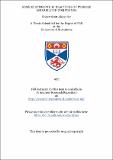Files in this item
Some electrophilic reactions of pyrrole and related compounds
Item metadata
| dc.contributor.advisor | Butler, Anthony (Anthony R.) | |
| dc.contributor.author | Alexander, Robert Scott | |
| dc.coverage.spatial | v, 120 p. | en_US |
| dc.date.accessioned | 2018-07-11T10:27:14Z | |
| dc.date.available | 2018-07-11T10:27:14Z | |
| dc.date.issued | 1977 | |
| dc.identifier.uri | https://hdl.handle.net/10023/15235 | |
| dc.description.abstract | Chapter One describes the mechanism of acid-catalysed hydrogen-exchange in methylpyrroles. Using buffer solutions it was found that this reaction is subject to general acid catalysis, confirming an A-S[sub]E2 mechanism. It was also found that the rate of hydrogen-exchange at the β-position of pyrrole was similar to that at the alpha-position. This seems to conflict with the known preference for alpha-substituted products obtained under 'synthetic' experimental conditions. However, both these findings have been rationalised in terms of the electron densities and the localisation energies prevalent in the pyrrole ring. The mechanism of the reaction between 4-dimethylamino-benzaldehyde (DMAB) and pyrroles in acid solution (Ehrlich's Reaction) is described in Chapter Two. This consists of a rate-determining electrophilic attack of O-protonated DMAB on unprotonated pyrrole followed by a rapid loss of a water molecule to give the highly-coloured conjugated product. The activating effect of methyl groups at various positions on the pyrrole ring on this reaction was also determined. Acid-catalysed hydrogen-exchange in methylthiophens is the subject of Chapter Three. In contrast to the situation found in pyrroles, the rate of exchange at the β-position of thiophen is much slower than at the alpha-position. An explanation for this is found in the difference in electron densities found in the two ring systems. The activating effect of methyl groups at various positions on the thiophen ring on the exchange reaction was also studied. It was found that these effects were not additive. The activating parameters for the exchange reactions at the alpha- and β-positions were also calculated and discussed. In Chapter Four the practical difficulties encountered in the quantitative determination of the clinically important pyrroles porphobilinogen and cryptopyrrole are discussed. A series of reagents were used in an attempt to improve on the present colourimetric test employing DMAB. It was found that the measurement of cryptopyrrole under acidic conditions is straightforward using DMAB, 2,4,6-trimethoxybenzaldehyde (TMB) or 2,4-bis(dimethylamino)benzaldehyde (BDMAB). In contrast to this situation, however, none of the reagents tested gave a completely stable coloured solution when reacted with aqueous porphobilinogen solutions. A test was devised, however, using the BDMAB reagent in acid solution which gave a colour, stable for up to 40 minutes, when reacted with test porphobilinogen solutions. | en_US |
| dc.language.iso | en | en_US |
| dc.publisher | University of St Andrews | |
| dc.subject.lcc | QD341.P9A6 | |
| dc.subject.lcsh | Pyrroles | en |
| dc.title | Some electrophilic reactions of pyrrole and related compounds | en_US |
| dc.type | Thesis | en_US |
| dc.contributor.sponsor | Science Research Council (Great Britain) | en_US |
| dc.type.qualificationlevel | Doctoral | en_US |
| dc.type.qualificationname | PhD Doctor of Philosophy | en_US |
| dc.publisher.institution | The University of St Andrews | en_US |
This item appears in the following Collection(s)
Items in the St Andrews Research Repository are protected by copyright, with all rights reserved, unless otherwise indicated.

